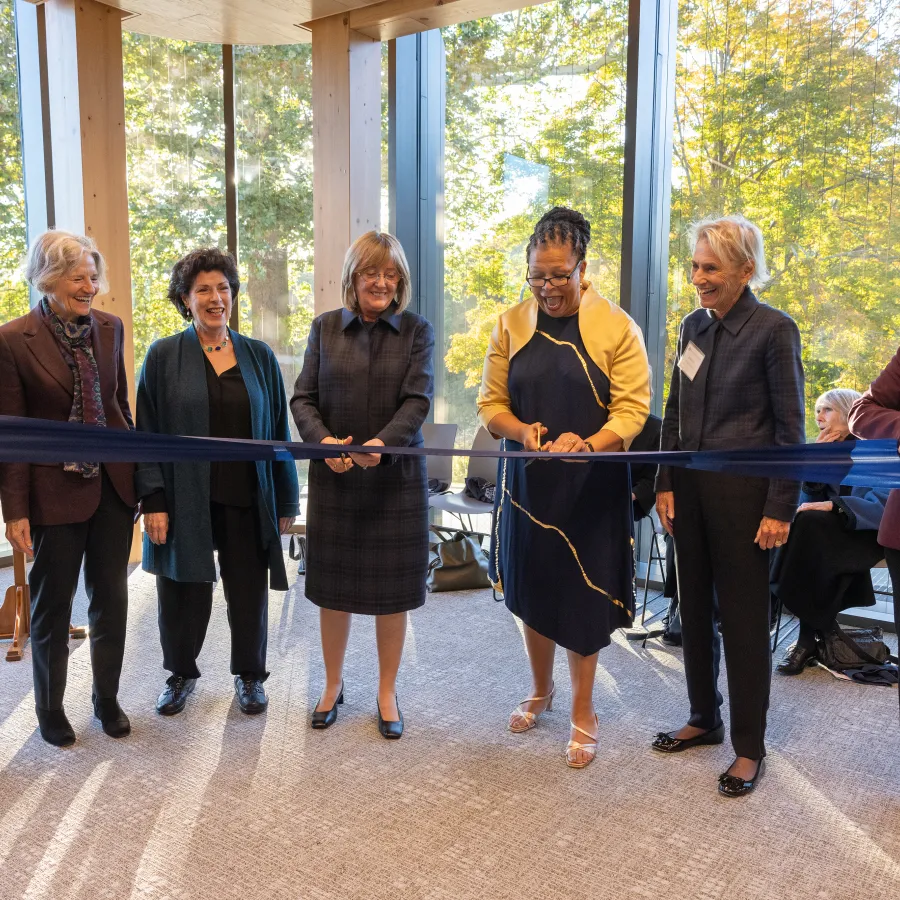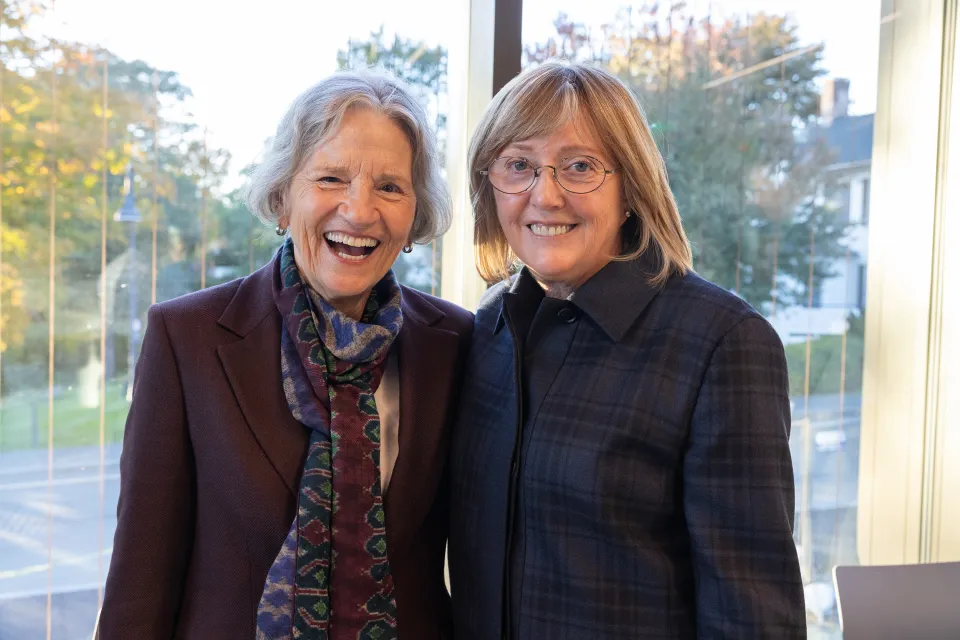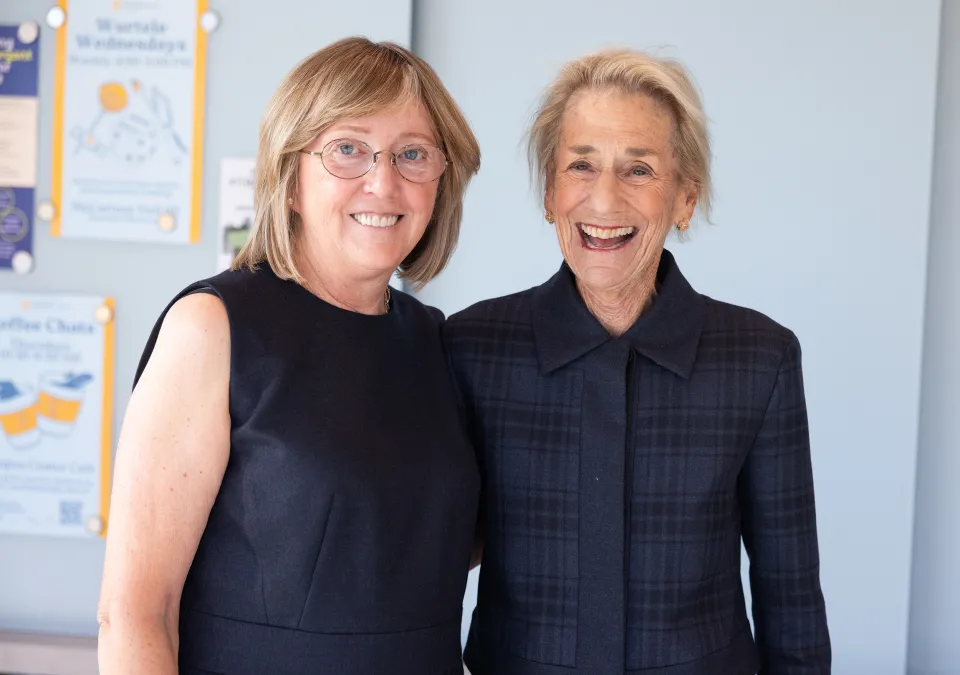Smith College’s McCartney Hall: A Place of Possibility
News of Note
The new building is the latest step in the college’s effort to reimagine career and leadership development

Published October 21, 2025
On a misty fall Friday afternoon, a line of hundreds of students snaked out the front door of Kathleen McCartney Hall, Smith College’s new 15,000-square-foot home for career and leadership development. Many came for the free Boba tea, but the staff inside were hoping for something more—that the students would stick around, explore the space, and see that the building, with its workshop rooms, interview spaces, and welcoming vibe, was designed specifically with their futures in mind.
The staff didn’t have to worry. Upstairs, in a bright classroom on the main level, students were jotting down messages in blue and red markers on dry-erase tables that reflected some of their early impressions:
“Love the big windows! The views are amazing.”
“I think I found my new favorite study spot.”
And then there was this simple declaration: “McCartney Hall Rocks!”
With the opening of McCartney Hall—made possible by a lead gift from Margaret Von Blon Wurtele ’67—Smith marks the next phase of its comprehensive effort to reimagine career and leadership development. At a dedication ceremony on October 17, President Sarah Willie-LeBreton called the new building a “bold investment in our students and their futures.” She noted that preparing students for meaningful work and equipping them with leadership skills are natural extensions of the liberal arts. “When we give students the tools of career exploration and leadership development, we give them agency to shape their own paths, the adaptability to face change, and the confidence to lead in a rapidly shifting world,” she said.

President Emerita Kathleen McCartney with Margaret Von Blon Wurtele ’67 (left)
Photo by Jessica Scranton
President emerita—and the building’s namesake—Kathleen McCartney joined in cutting the ceremonial ribbon. For her, the moment was deeply personal—a reflection of her own path as the first in her family to attend college and a reminder of what’s possible when students are encouraged to dream big and reach beyond their circumstances. “For this first-gen student, this is all a dream come true,” she said. The building, she added, is a symbol of possibility. “Here, students can discover who they are and what they want to become,” McCartney said. “They can develop a leadership style that fits them as the individuals they are.”
A few days before the dedication ceremony, Faith McClellan, dean of career development, sat in her new office on the second floor and reflected on the promise of the new building and what it will mean for new generations of Smith students. Bringing career development and leadership training together under one roof, she said, allows for “a more holistic and integrated approach.” “We’ll have flexible spaces for students to do the work in and around the edges of career and leadership exploration,” McClellan said. “They might come in for one purpose but actually leave with another.”
This spirit of self-examination and discovery is central to the philosophy behind the building’s design. “We want students to feel free to explore and find new things—about the building and themselves,” McClellan said. “That is a fundamental tenet of the liberal arts as well as how we think about career development.”
McCartney Hall opens at a time when students and families are more focused than ever on the return on their educational investment. In response, the Lazarus Center and the Wurtele Center for Collaborative Leadership are developing a collaborative vision for career and leadership development that helps students identify their passions and guides them at every step toward meaningful, impactful careers.
Visitors to McCartney Hall are greeted by a palette of rich earth tones of blue, red, gray, yellow, and green. Comfortable couches, bowls full of candy, and colorful flowers brighten the main lobby and lounge area. Mascots Lazzy the Lizard and Wurtele the Turtle add a playful touch. Flexible classrooms and collaborative meeting spaces are equipped with up-to-date technology, movable furniture, and plenty of white boards for, as McClellan said, “doodling and dreaming.” Large floor-to-ceiling windows flood the building with natural light—an intentional design feature meant to reinforce the message that all are welcome, according to Alexandra Keller, dean of the college and vice president for campus life. “There’s something really important about creating a sense of visibility, so students can see not only what’s happening inside the building but also see that they belong here, that they have an opportunity to shape the space and what happens in it,” Keller said.

President Emerita Kathleen McCartney (left) with Rochelle (Shelly) Braff Lazarus ’68.
Photo by Jessica Scranton
On the main level, students can access private interview suites as well as a clothes closet stocked with new donated suits and other professional attire, including nonbinary and size-inclusive options. Offices line the hallways to encourage easy interaction between students, staff, and advisers. “The intent is to be very approachable and open,” McClellan said. “One of the goals is to reduce the intimidation factor so that students can build relationships. Everything good in career exploration and collaborative leadership happens through relationships.”
In keeping with Smith’s commitment to sustainability, McCartney Hall was designed for maximum energy efficiency. The women-led architectural firm TenBerke incorporated sustainable materials—glass, stone, wood, and responsibly sourced mass timber, which emits less greenhouse gas during production and installation, according to Beth Hooker, senior director for sustainability—into every detail, from the building’s framing to its cabinetry. Geothermal energy powers its heating and cooling systems, and a living roof, planted with 870 square feet of native species, offers both environmental benefits and stunning views of Paradise Pond and the surrounding valley.
For Erin Park Cohn ’00, director of the Wurtele Center, the building’s greatest promise lies in its potential for collaboration among students and between the Lazarus and Wurtele centers. “We’re looking forward to activating this building as a space where students will feel empowered to experiment with possible ways of being in the world, both while they’re at Smith and once they graduate,” Cohn said.
She’s most excited to see students using the Wurtele classroom on the main level. With its movable furniture, sticky notes and markers, and erasable tabletops, it’s a space designed to inspire collaborative learning and big thinking. In her spring course, Critical Perspectives on Collaborative Leadership, Cohn plans to have groups of students maximize their use of the space for an intensive group project. The intent, Cohn said, is to encourage students to “visualize their thinking while working together and to cluster and reconfigure the room in lots of different ways. It’s a space that really invites collaboration and ignites creativity.”
This type of learning has far-reaching benefits in developing leaders who can tackle the world’s complex problems. “The return on investment is huge for our society,” Cohn said.
Meanwhile, McClellan hopes that students “define and redefine, and claim and inhabit” McCartney Hall as their needs and interests change. “This building allows us to engage with the big questions shaping the future of work and leadership,” she said. “How do students find careers that are both remunerative and impactful? How do they learn to lead in big and small ways? We want students to be right in the middle of those conversations with us.”